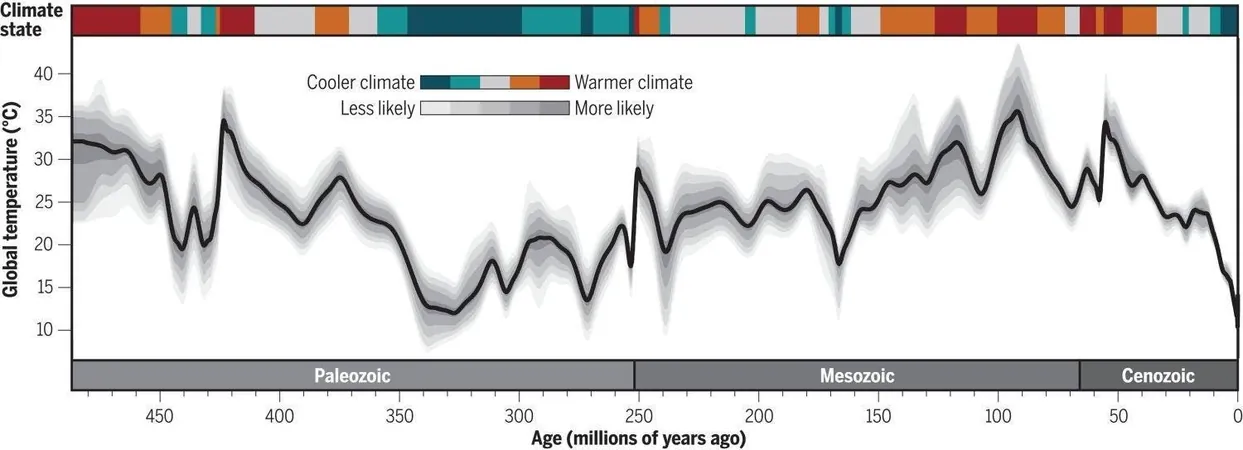
Shocking 485 Million Year Temperature Saga Revealed: What It Means for Our Future!
2024-09-22
A Groundbreaking Study Unveiled
A groundbreaking new study has unveiled an intricate history of Earth's surface temperature, spanning an astounding 485 million years throughout the Phanerozoic eon. This incredible research takes us from 538.8 million years ago right up to the present day, shedding light on how our planet's climate has fluctuated dramatically over millions of years.
Cutting-Edge Techniques Used
Utilizing a cutting-edge technique known as data assimilation, the international team of researchers has crafted a detailed temperature curve, revealing that Earth's temperature variability has been far greater than previously understood. Importantly, the findings confirm a strong correlation between atmospheric carbon dioxide levels and Earth's temperature, emphasizing the role of greenhouse gases in historical climate shifts.
Ancient Climate Reconstruction
To reconstruct ancient climates, scientists analyzed fossil distribution, chemical signatures of ancient shells, and even preserved organic matter from long-extinct species. Remarkably, even rocks and minerals have served as indicators of past climates, with salt deposits signaling arid conditions and glendonites pointing to cold aquatic environments.
Development of PhanTASTIC Database
The research team compiled a formidable database named PhanTASTIC (Phanerozoic Technique Averaged Surface Temperature Integrated Curve Project), synthesizing over 150,000 published data points with more than 850 model simulations created by their colleagues at the University of Bristol. This unique combination of data allowed researchers to paint a more precise picture of Earth's temperature fluctuations over time.
Temperature Range and Climate Shifts
Findings indicate that global mean surface temperatures over the Phanerozoic have ranged from 52°F to 97°F (11°C to 36°C). Notably, extreme temperature spikes were predominantly linked to high atmospheric carbon dioxide levels, with solar input being a more minor influence. This vital information provides crucial context for deciphering modern climate change, which is occurring at an unprecedented rate compared to historical warming events.
Expert Insights on Modern Climate Change
Scott Wing, curator of paleobotany at the Smithsonian, highlights the disparity between modern expectations and historical climate data, urging that understanding ancient warm periods is critical to predicting future climate scenarios. "The earth is currently experiencing rapid warming due to human-induced greenhouse gas emissions, which is fundamentally different from any events observed in the last few million years," he states.
Risks of Rapid Climate Change
Worryingly, while our planet has experienced a cooler climate in the last 10 to 20 million years, the current pace of anthropogenic climate change is surpassing even the swiftest historical warming recorded. Jessica Tierney, a leading paleoclimatologist, warns, "Humans and the species we share this planet with are adapted to a colder climate. Rapidly transitioning to a warmer climate poses significant risks."
Historical Context of Mass Extinctions
The historical record also raises alarm bells, as episodes of rapid climate change during the Phanerozoic have coincided with mass extinctions. This paints a stark picture of the possible consequences of failing to address current climate challenges.
Ongoing Research and Insights
Intriguingly, despite being a comprehensive study, experts such as Brian Huber, curator of the micropaleontology collection, assert that our understanding of Earth’s temperature history is still a work in progress. Additional research will continue to provide insights that could refine the temperature curve further, enhancing our understanding of deep-time climate dynamics.
Conclusion and Further Reading
The full study, titled "A 485-million-year history of Earth’s surface temperature," has been published in the peer-reviewed journal Science and can provide readers with further insights into this pivotal research that may shape our understanding of the planet's future climate. Stay tuned—gaining insights from this vast temporal tapestry could be crucial for navigating the climate crisis we face today!


 Brasil (PT)
Brasil (PT)
 Canada (EN)
Canada (EN)
 Chile (ES)
Chile (ES)
 España (ES)
España (ES)
 France (FR)
France (FR)
 Hong Kong (EN)
Hong Kong (EN)
 Italia (IT)
Italia (IT)
 日本 (JA)
日本 (JA)
 Magyarország (HU)
Magyarország (HU)
 Norge (NO)
Norge (NO)
 Polska (PL)
Polska (PL)
 Schweiz (DE)
Schweiz (DE)
 Singapore (EN)
Singapore (EN)
 Sverige (SV)
Sverige (SV)
 Suomi (FI)
Suomi (FI)
 Türkiye (TR)
Türkiye (TR)